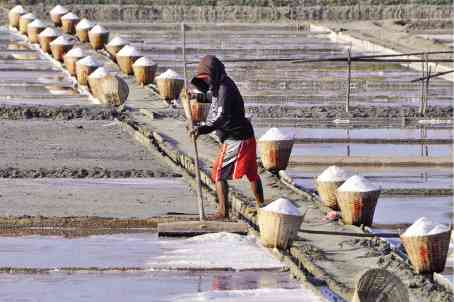In Pangasinan, salt farms start drawing attention of tourists

LAND OF SALTPangasinan derives its name from salt produced by farms in the western section of the province. Salt production has been generating livelihood for local farmers for 80 years. —WILLIE LOMIBAO
DASOL, PANGASINAN—The sprawling salt farms in this western Pangasinan town are fast becoming tourist attractions.
Curious motorists have been dropping by the farms along the highway to watch workers harvest salt, while local government officials from different provinces have been coming here to learn salt production, according to Vilma Nifas, the town’s agriculturist.
“We just had visitors from Region IV-A (Calabarzon) and from Bukidnon (province) who wanted to see the farms,” said Nifas in an earlier interview.
This town, which has about 10,000 “banigan” (salt beds) in 11 of its 18 villages, produces 18,000 metric tons (MT) of salt every year, making it the province’s leading salt producer.
A 1993 study conducted by the Nutrition Center of the Philippines showed that salt from this town, combined with those produced in the towns of Bolinao and Bani and Alaminos City, totaled 74,765 MT, the highest salt production by a province in the country for that year.
Pangasinan was tailed by the provinces of Bulacan (71,419 MT) and Occidental Mindoro (38,002 MT).
According to agricultural technologist Ma. Frieda Briz, Pangasinan may still be the country’s top salt producer today because many salt farms in Bulacan have been converted into fish ponds.
“Some of the salt farm owners in Bulacan have come here to sell the tiles from their salt beds,” Briz said.
Salt-making has been one of the town’s major sources of livelihood here in the last eight decades.
According to Briz, one farm worker tends to 25 banigan, which means that as many as 400 farm workers directly benefit from the town’s salt industry.
The workers usually start cleaning the tiled beds at the start of the salt-making season in October and harvest salt from December to May, before the start of the rainy season.
A worker earns a third of the total salt produced from the 25 banigan.
A bed measuring 5.5 meters (18 feet) by 6 meters (20 feet) produces 30 sacks, each sack weighing 60 kilograms.
“During peak season, which begins in March, the farm worker hires a helper. So that’s another 400 beneficiaries,” Briz said. “Then there are the boatmen, who transport the salt to the wharf, porters and basket makers.”
The salt farms here are located along the Maasin River, one of the rivers cutting through the town that flows to the Dasol Bay.
The salt-making process starts by flooding the beds with seawater stored in a series of ponds within the farm. The ponds are necessary, because neap tide takes place twice a month and seawater does not flow toward the river.
Briz said the water level in the beds must be just enough for the sun to dry up the whole day. By noon, the salt beds turn white, indicating that salt crystals have been formed.
Before sunset, the farm worker, using a rake, collects the salt in a bamboo basket, which he hauls into a store room. The salt is packed in sacks and collected by buyers.
The salt industry is unique to Pangasinan so salt farms have been part of the province’s tourism product development, according to Ma. Luisa Elduayan, provincial tourism officer.
“The salt farms are aligned with the promotion of farm tourism, which should not be limited to agricultural farms,” she said.
Except for the salt farm in Bolinao, the Dasol salt farms had yet to be included in tour packages being promoted and sold for the province, she said.
According to Nifas, the salt industry here has thrived because the town has kept its rivers clean.
“Our priority is to protect the environment. This is why we are maintaining a 114-hectare mangrove area which we want to be declared as a marine protected area. The mangroves serve as a natural filter. Before the seawater reaches our salt farms, it’s already filtered,” Nifas said.
The town government has not allowed fish cages and pens to be built along the rivers to protect the salt industry.
“We are also very strongly against against mining. This is our only way of keeping the good quality of the salt that we produce,” she said.
If sea water is dirty, the salt produced is yellowish, not the shiny, white crystal that it is
today.
For its effort, the town was adjudged regional champion in coastal resources management in 2014 and 2015. It has also won awards for having the cleanest coastal river.
Mayor Eric Verzosa said the local government held the Asin Festival last week to promote Dasol’s leading product.














